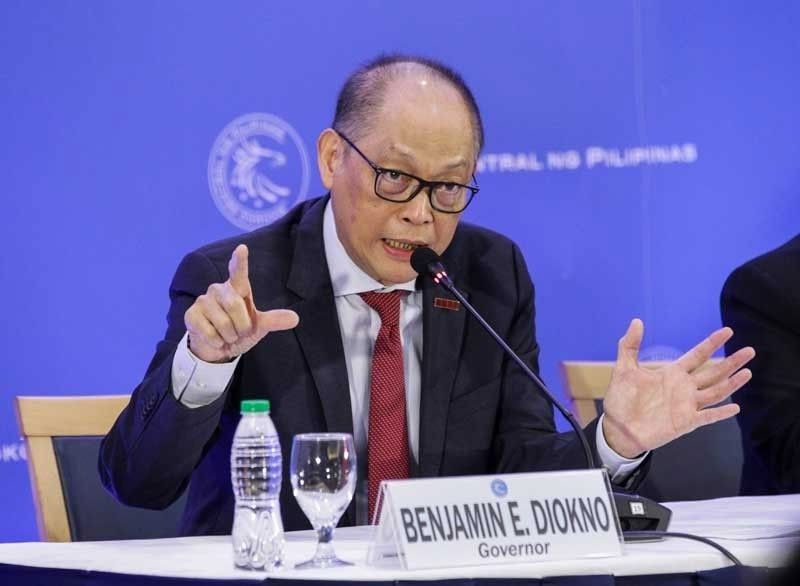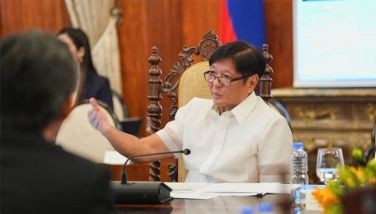Diokno warns of fiscal collapse from uniformed personnel pensions

MANILA, Philippines — The Marcos administration is pushing to overhaul the pension system for the military and uniformed personnel (MUP) to avert fiscal collapse stemming from higher pension costs, Finance Secretary and economic team head Benjamin Diokno said yesterday.
According to Diokno, President Marcos has agreed to reform the pension system for MUP to address the country’s fiscal deficit.
The current MUP pension system is non-contributory and, as such, retirement pensions and benefits are fully funded by the government through annual appropriations.
“His predecessors did not want to address this. It’s the elephant in the room and nobody would like to touch it and they simply ignore it,” Diokno said at a press briefing.
“It is not sustainable and if it goes on, there will be a fiscal collapse. They have to cooperate with the rest of society otherwise, our fiscal deficit will just continue to balloon,” he added.
Under the 2023 budget, the Pension and Gratuity Fund (PGF) has an allocation of P272.94 billion, almost 50 percent higher than the 2022 level of P183.94 billion.
The annual fund is meant to pay pension retirement gratuity and terminal leave benefits, including separation benefits and incentives.
It should be noted that the monthly pension of retirees is automatically indexed to the salary of the next in rank in the active service.
Hence, salary adjustments for active personnel increase the funding requirement for retirees.
Another pressure is the option of uniformed personnel to avail themselves of early retirement after at least 20 years of service, ahead of the mandatory retirement age of 56.
“We want to reform them because the situation right now is so bleak,” Diokno said. “If you compare the operating and maintenance expenditure of the AFP (Armed Forces of the Philippines), the capital outlay is actually much less than the amount of pension that we are allocating for retirees.”
To compare, uniformed personnel are getting P40,000 in pension per month even without their contribution. This is nine times higher than the P4,528 pension received by the private sector through the Social Security System.
It is also three times above the P13,600 monthly pension of state workers under the Government Service Insurance System.
Diokno proposed that once the new system is implemented, all those in service and new recruits will pay their way, which means pension is no longer free.
It will also be equivalent to the payment scheme of state workers with the contributions depending on the salary.
Diokno said the implementation of the proposed pension system would be gradual.
For the first three years, the MUP will shoulder the five percent of the salary as contribution while the government will pay 16 percent to reach the 21 percent standard rate. This will eventually be adjusted to a 7:14 and 9:12 ratio between the MUP and the government.
The automatic indexation will also be removed while uniformed personnel will receive their pension at the mandatory retirement age of 56.
“In general, the Cabinet is in agreement with all the measures. The President also agreed,” Diokno said.
Such a reform will have to go through Congress, Diokno said, adding the government is in talks with some lawmakers to push for the measure.
“The President recognizes the need for this. I think President Marcos is in the best position to push through with this, his predecessors kicked the can without success,” Diokno said.
“If he doesn’t do this, there will be fiscal collapse in the future. President Marcos has strong control of both houses of Congress. It will be less problematic for him to push forward such a major reform,” he added.
Landbank-DBP merger
Meanwhile, the government will save about P5.3 billion per year should the proposed merger of state-run Land Bank of the Philippines and Development Bank of the Philippines (DBP) push through, according to Diokno.
At a press briefing yesterday, Diokno said Marcos backed the merger in light of the recent financial developments overseas.
“The President expressed the desire to merge the two to make it the biggest bank in the country because of the recent financial developments abroad. And that’s really the best practice – the biggest bank usually is owned by the state globally,” he said.
“For the projected operating cost savings due to the merger, it could reach at least P5.3 billion per year. So for the next four years, at least P20 billion, OK, and this is even understated,” Diokno added.
The amount, he pointed out, does not include the revenues that can be derived from the sale of redundant assets of DBP’s various properties such as its head office in Makati, a property in Bonifacio Global City, among others.
The proposed merger of the two lending institutions was among the topics discussed during Marcos’ meeting with his economic team at Malacañang yesterday.
The President expressed concern over the possible effects of the merger on the banks’ services, according to Diokno.
“Now, he expressed concern that in the process of merging, that none of the services provided by either bank will be lost,” the finance chief said.
“And we assured him that with the merger, because both the Landbank and DBP are universal banks, they do almost the same, right, except that one is focused on agricultural and the other one on industrial projects, but they do practically the same…there will be savings and the merged bank will be stronger,” Diokno added.
He said the merger may even result in lower interest rates being imposed by the banks.
To date, Landbank has 752 branches while DBP has 147.
Being the much larger entity, Landbank is expected to be the surviving entity in the potential merger, Diokno said.
“As a result of the merger, only 22 branches of DBP will be retained and the plan is that Landbank will have a branch in all LGUs (local government units) in the Philippines,” Diokno said.
In 2016, Marcos opposed the merger of Landbank and DBP, saying it would deprive farmers access to the agricultural bank.
Asked about Marcos’ supposed change of stance on the Landbank-DBP merger, Diokno said, “He has not changed his mind since he was elected president. I know that he was for this proposal.”
The last time that a state-owned bank dominated the local banking system was during the term of the late former president Fidel Ramos, when Philippine National Bank was still controlled by the government. – Alexis Romero, Helen Flores
- Latest
- Trending
































